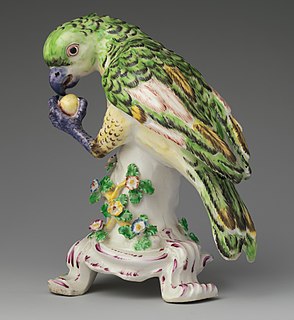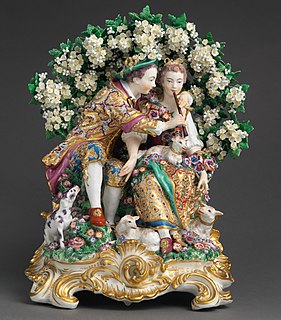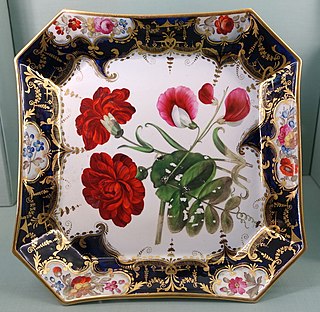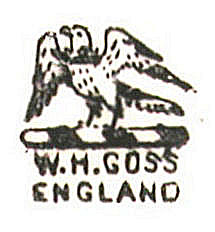 W
WThe Bow porcelain factory was an emulative rival of the Chelsea porcelain factory in the manufacture of early soft-paste porcelain in Great Britain. The two London factories were the first in England. It was originally located near Bow, in what is now the London Borough of Tower Hamlets, but by 1749 it had moved to "New Canton", sited east of the River Lea, and then in Essex, now in the London Borough of Newham.
 W
WBristol porcelain covers porcelain made in Bristol, England by several companies in the 18th and 19th centuries. The plain term "Bristol porcelain" is most likely to refer to the factory moved from Plymouth in 1770, the second Bristol factory. The product of the earliest factory is usually called Lund's Bristol ware and was made from about 1750 until 1752, when the operation was merged with Worcester porcelain; this was soft-paste porcelain.
 W
WMessrs. Thomas C. Brown-Westhead, Moore & Co. was a manufacturer of China, earthenware, including high quality innovative Victorian majolica and sanitary goods at Cauldon Place, Stoke-upon-Trent in England from 1856.
 W
WThis is a list of Royal Doulton Bunnykins figurines. Doulton & Co. introduced the Bunnykins figurines in 1939 with six original Bunnykins figurines designed by Charles Noke based on illustrations by Sister Mary Barbara Bailey. Shortly thereafter, and prior to World War II, Doulton & Co. discontinued their manufacture. After Royal Doulton purchased the Beswick Pottery factory in 1969, Royal Doulton reintroduced the Bunnykins figurines. After the closure of Royal Doulton factory in England in 2005, Bunnykins figurines are produced in Asia. The Bunnykins figurines are in ascending order and include the name of the figurine, designer/modeler, date introduced, and the date discontinued.
 W
WThe Cambrian Pottery was founded in 1764 by William Coles in Swansea, Glamorganshire, Wales. In 1790, John Coles, son of the founder, went into partnership with George Haynes, who introduced new business strategies based on the ideas of Josiah Wedgwood. Lewis Weston Dillwyn became a partner in 1802 and sole owner when George Haynes left the pottery in 1810.
 W
WThe Canadian Historical Dinner Service, originally called the Cabot Commemorative State Dinner Service, is 204-piece eight-course dinner service with 24 place settings of hand-painted porcelain. It was created in 1896–97 to commemorate the 400th anniversary of the first visit to Canada by a European, John Cabot. The illustrations all have Canadian subjects, and no two pieces are the same.
 W
WRichard Champion (1743–1791) was an English merchant and porcelain manufacturer, who emigrated to the United States in 1784.
 W
WChelsea porcelain is the porcelain made by the Chelsea porcelain manufactory, the first important porcelain manufactory in England, established around 1743–45, and operating independently until 1770, when it was merged with Derby porcelain. It made soft-paste porcelain throughout its history, though there were several changes in the "body" material and glaze used. Its wares were aimed at a luxury market, and its site in Chelsea, London, was close to the fashionable Ranelagh Gardens pleasure ground, opened in 1742.
 W
WA chinaman is a dealer in porcelain and chinaware, especially in 18th-century London, where this was a recognised trade; a "toyman" dealt additionally in fashionable trifles, such as snuffboxes. Chinamen bought large quantities of Chinese export porcelain and Japanese export porcelain landed by the East India Company, who held auctions twice a year in London. The traders then distributed chinaware throughout England.
 W
WCoalport, Shropshire, England was a centre of porcelain and pottery production between about 1795 and 1926, with the Coalport porcelain brand continuing to be used up to the present. The opening in 1792 of the Coalport Canal, which joins the River Severn at Coalport, had increased the attractiveness of the site, and from 1800 until a merger in 1814 there were two factories operating, one on each side of the canal, making rather similar wares which are now often difficult to tell apart.
 W
WThe production of Derby porcelain dates from the second half of the 18th century, although the authorship and the exact start of the production remains today as a matter of conjecture. The oldest remaining pieces in the late 19th century bore only the words "Darby" and "Darbishire" and the years 1751-2-3 as proof of place and year of manufacture. More important is the fact that the production of porcelain in Derby predates the commencement of the works of William Duesbury, started in 1756 when he joined Andrew Planche and John Heath to create the Nottingham Road factory, which later became the Royal Crown Derby.。
 W
WGoss crested china is typically in the form of small white glazed porcelain models, made from 1858 to 1939, carrying the coat of arms of the place where they were sold as a souvenir, thus being a form of model heraldic china.
 W
WThe Herculaneum Pottery was based in Toxteth, Liverpool, England. between 1793/94 and 1841. They made creamware and pearlware pottery as well as bone china porcelain.
 W
WLiverpool porcelain is mostly of the soft-paste porcelain type and was produced between about 1754 and 1804 in various factories in Liverpool. Tin-glazed English delftware had been produced in Liverpool from at least 1710 at numerous potteries, but some then switched to making porcelain. A portion of the output was exported, mainly to North America and the Caribbean.
 W
WThe Lowestoft Porcelain Factory was a soft-paste porcelain factory on Crown Street in Lowestoft, Suffolk, England, which was active from 1757 to 1802. It mostly produced "useful wares" such as pots, teapots, and jugs, with shapes copied from silverwork or from Bow and Worcester porcelain. The factory, built on the site of an existing pottery or brick kiln, was later used as a brewery and malt kiln. Most of its remaining buildings were demolished in 1955.
 W
WThe Nantgarw China Works was a porcelain factory, later making other types of pottery, located in Nantgarw on the eastern bank of the Glamorganshire Canal, 8 miles (13 km) north of Cardiff in the River Taff valley, Glamorganshire, Wales. The factory made porcelain of very high quality, especially in the years from 1813-1814 and 1817-1820. The body was extremely white and translucent, and was given overglaze decoration of high quality, mostly in London or elsewhere rather than at the factory. The wares were expensive, and mostly distributed through the London dealers. Plates were much the most common shapes made, and the decoration was typically of garlands of flowers in a profusion of colours, the speciality of the founder, William Billingsley. With Swansea porcelain, Nantgarw was one of the last factories to make soft-paste porcelain, when English factories had switched to bone china, and continental and Asian ones continued to make hard-paste porcelain.
 W
WParian ware is a type of biscuit porcelain imitating marble. It was developed around 1845 by the Staffordshire pottery manufacturer Mintons, and named after Paros, the Greek island renowned for its fine-textured, white Parian marble, used since antiquity for sculpture. It was also contemporaneously referred to as Statuary Porcelain by Copeland. Parian was essentially designed to imitate carved marble, with the great advantage that it could be prepared in a liquid form and cast in a mould, enabling mass production.
 W
WPinxton Porcelain was a porcelain works created by John Coke and William Billingsley in Pinxton in Derbyshire, England.
 W
WPlymouth porcelain was the first English hard paste porcelain, made in the county of Devon from 1768 to 1770. After two years in Plymouth the factory moved to Bristol in 1770, where it operated until 1781, when it was sold and moved to Staffordshire as the nucleus of New Hall porcelain, which operated until 1835. The Plymouth factory was founded by William Cookworthy. The porcelain factories at Plymouth and Bristol were among the earliest English manufacturers of porcelain, and the first to produce the hard-paste porcelain produced in China and the German factories led by Meissen porcelain.
 W
WThe Rockingham Pottery was a 19th-century manufacturer of porcelain of international repute, supplying fine wares and ornamental pieces to royalty and the aristocracy in Britain and overseas, as well as manufacturing porcelain and earthenware items for ordinary use.
 W
WCoalport, Shropshire, England was a centre of porcelain and pottery production between about 1795 and 1926, with the Coalport porcelain brand continuing to be used up to the present. The opening in 1792 of the Coalport Canal, which joins the River Severn at Coalport, had increased the attractiveness of the site, and from 1800 until a merger in 1814 there were two factories operating, one on each side of the canal, making rather similar wares which are now often difficult to tell apart.
 W
WThe Royal Crown Derby Porcelain Company is the oldest or second oldest remaining English porcelain manufacturer, based in Derby, England. The company, particularly known for its high-quality bone china, having produced tableware and ornamental items since approximately 1750. It was known as 'Derby Porcelain' until 1773, when it became 'Crown Derby', the 'Royal' being added in 1890. The factory closed down in the past under Royal Doulton ownership, but production was revived under the renewed ownership of Hugh Gibson and Pearson family.
 W
WRoyal Doulton is an English ceramic and home accessories manufacturer founded in 1815. Operating originally in Vauxhall, London, later moving to Lambeth, in 1882 it opened a factory in Burslem, Stoke-on-Trent, in the centre of English pottery. From the start the backbone of the business was a wide range of utilitarian wares, mostly stonewares, including storage jars, tankards and the like, and later extending to pipes for drains, lavatories and other bathroom ceramics. From 1853 to 1902 its wares were marked Doulton & Co., then from 1902, when a royal warrant was given, Royal Doulton.
 W
WRoyal Doulton Bunnykins tableware and figurines are popular ceramic designs manufactured as nursery dishes and collectible figurines. The chinaware line originated with artwork by Sister Mary Barbara Bailey, the daughter of Cuthbert Bailey, general manager of Doulton during the 1930s. Unbeknownst to the public, Mary Barbara Bailey was not a professional illustrator, but a nun in the Augustinian Canonesses of the Lateran. Sister Mary Barbara provided illustrations to the designers of Doulton & Co. to be used on tableware. Six Bunnykins figurines were produced based on Sister Mary Barbara's illustrations in 1939 and were designed by Charles Noke. Discontinued during World War II, Bunnykins figurines were not reintroduced until 1969. Bunnykins continued to be produced in England until 2005. Bunnykins figurines and tableware are currently produced in Asia.
 W
WRoyal Worcester was established in 1751 and is believed to be the oldest or second oldest remaining English porcelain brand still in existence today. Part of the Portmeirion Group since 2009, Royal Worcester remains in the luxury tableware and giftware market, although production in Worcester itself has ended.
 W
WSpode is an English brand of pottery and homewares produced by the company of the same name, which is based in Stoke-on-Trent, England. Spode was founded by Josiah Spode (1733–1797) in 1770, and was responsible for perfecting two extremely important techniques that were crucial to the worldwide success of the English pottery industry in the century to follow.
 W
WThe Staffordshire Potteries is the industrial area encompassing the six towns, Burslem, Fenton, Hanley, Longton, Stoke and Tunstall, that now make up the city of Stoke-on-Trent in Staffordshire, England. North Staffordshire became a centre of ceramic production in the early 17th century, due to the local availability of clay, salt, lead and coal.
 W
WWedgwood is a fine china, porcelain, and luxury accessories manufacturer that was founded on 1 May 1759 by the English potter and entrepreneur Josiah Wedgwood and was first incorporated in 1895 as Josiah Wedgwood and Sons Ltd. It was rapidly successful and was soon one of the largest manufacturers of Staffordshire pottery, "a firm that has done more to spread the knowledge and enhance the reputation of British ceramic art than any other manufacturer", exporting across Europe as far as Russia, and to the Americas. It was especially successful at producing fine earthenware and stonewares that were accepted as equivalent in quality to porcelain but were considerably cheaper.